ISSN ONLINE(2319-8753)PRINT(2347-6710)
ISSN ONLINE(2319-8753)PRINT(2347-6710)
B.Ramesh1, A.Elayaperumal2, D.Ajay Balaji3, N.Rakesh4
|
| Related article at Pubmed, Scholar Google |
Visit for more related articles at International Journal of Innovative Research in Science, Engineering and Technology
Nonlaminated composites having superior mechanical properties than laminated composites is widely used in ballistic applications. Since literature on the machinability of nonlaminated composites is scarce, an investigation was carried out to study the hole quality in drilling thick nonlaminated Glass Fiber Reinforced Plastic (GFRP) composite rods using coated tungsten carbide twist drill. The GFRP composite rods were made by pultrusion method with high fiber weight fraction. The ovality (hole diameter inaccuracy) of the drilled holes was measured using Coordinate Measuring Machine (CMM). Taguchi‟s orthogonal array and analysis of variance (ANOVA) were employed to study the influence of process parameters such as feed and spindle speed on ovality of the drilled holes. The optimum level of process parameters towards minimum ovality was obtained to achieve defect controlled drilling of pultruded GFRP composite rods. Correlation for ovality with process parameters was established using a statistical software MINITAB 16. The influence of speed on ovality was insignificant. The influence of feed was significant on ovality of the drilled holes. The optimal process parameter levels within the range examined was identified as 0.15 mm/rev feed and 1000 rpm speed for pultruded GFRP composite rods using 10 mm diameter twist drill. The influence of process parameters on hole quality in nonlaminated composite rods differs with drill geometry and also differs from the influence of process parameters on hole quality in laminated composites
Keywords |
| GFRP, Nonlaminated composite rods, Drilling, Ovality, Taguchi method, ANOVA, S/N analysis. |
INTRODUCTION |
| Glass fiber reinforced plastic (GFRP) composites are most widely used in aerospace, automobile, marine, electronic industries, construction of military vehicles, machine tools, robots and sports equipment owing to their multi potential properties such as high strength to weight ratio, high specific stiffness, high damping, high fracture toughness, good dimensional stability and excellent corrosion resistance [1],[2]. Accordingly, the need for accurate machining of composites has increased enormously. Intricacy in the product design necessitates development of the composite product in parts, which are finally assembled. Hole making thus becomes an integral part of the product development cycle. During drilling of fiber reinforced composites, the work material experiences delamination, fiber breakage, matrix cracking, etc. [3],[4]. Among these defects caused by drilling, delamination which occurs both at the entrance and exit planes of the workpiece is most critical, since it can result in lowering of bearing strength and thereby reduces service life of the component [3],[5],[6]. Hence, utmost care is to be exercised to attain defect controlled drilling performance. The fastening efficiency is largely dependent on the bearing strength which defines the quality of machined holes. Many researchers have proposed that the quality of machined holes is strongly dependent on process parameters such as feed and spindle speed [2],[3],[7]-[10] which have great influence on the thrust force and torque. Many attempts have been made by various researchers in drilling laminated GFRP composites. They are briefly presented here. Malhotra [1] and Arul et al. [2] stated that carbide tipped drill performs much better than HSS drill with GFRP. Caprino et al. [4] stated that the type of damage induced in glass/polyester composite materials during drilling is strongly dependent on the feed rate. Di Ilio et al. [7] characterized the interaction between the twist drill and the composite during machining. Paulo Davim et al. [8] employed a statistical technique, using orthogonal arrays and analysis of variance, to investigate the influence of cutting parameters in machining Glass Fiber Reinforced Plastics (GFRPs) manufactured by hand lay-up. Mohan et al. [9] analyzed the influence of machining parameters on thrust force and torque during drilling glass fiber reinforced polyester composite materials. |
| König et al. [11] stated that cutting forces such as thrust force and torque which depend on cutting parameters affects the surface quality. Wen-Chou Chen [12] correlated the delamination factor with the average thrust force for the drilling of uni-directional and multidirectional composite materials. Enemuoh et al. [13] proposed an approach combining TaguchiâÃâ¬ÃŸs technique and multi-objective optimization criterion to select global optimum drilling parameters for damage-free drilling in carbon fiber reinforced epoxy composite materials. Tsao et al. [14] predicted and evaluated delamination factor in drilling carbon fiber reinforced plastics (CFRPs) based on TaguchiâÃâ¬ÃŸs method and the analysis of variance (ANOVA). Ogawa et al. [15] stated that the mean value (static component) of the thrust force influences on a cutting phenomenon occurring at the chisel edge of the drill and the magnitude of variation (dynamic component) of the thrust force influences on a cutting phenomenon occurring at the major cutting edge of the drill. Singh and Bhatnagar [16] drilled UD-GFRP laminates with different drill geometries and concluded that drilling-induced damage is not only dependent on thrust force alone but also on torque. They also found that the damage is maximum at higher cutting speeds and minimization of thrust force and torque during drilling can lead to minimal damage of the hole. Ramesh and Elayaperumal [17] stated that feed is only significant in influencing thrust force and torque and obtained optimal process parameter levels for drilling high fiber volume fraction nonlaminated composite rods. Ramesh et al. [18] optimized the process parameter levels for surface roughness and ovality of the drilled holes in nonlaminated composited rods. They used a special geometry drill called ratio drill for their experiments. The literature review shows that many researchers have worked towards attaining hole quality considering thrust force, torque and damage/delamination around the drilled hole in laminated composites. However, literature on the drilling of nonlaminated composite materials is scarce. Nonlaminated composites, because of its superior properties than laminated composites, finds application in construction of bridges, prefabricated walkways and platforms, bus components, ballistic applications etc. In ballistic applications mostly thick nonlaminated composites with higher percentage of fiber weight fraction is used to ensure higher order energy absorption. Hence the research interest in the present study was to investigate the influence of drilling process parameters such as feed and spindle speed on ovality (hole diameter inaccuracy) of the drilled holes and attaining optimal process parameter levels in the selected range for hole quality considering minimum ovality of the drilled holes in high fiber weight fraction glass/epoxy thick nonlaminated composite rods. This paper presents the application of TaguchiâÃâ¬ÃŸs orthogonal array and analysis of variance (ANOVA) to study the relative influence of process parameters and analysis of Signal-to-Noise ratio for attaining optimal parameter levels. If ovality of the drilled holes can be minimized, the bearing strength of the drilled holes and the service life of the assembled components can be substantially increased. |
II. EXPERIMENTAL DETAILS |
| Pultruded rod which is a GFRP polymeric (epoxy) nonlaminated composite (Fig. 1) with maximum fiber weight fraction was taken as workpiece. Pultruded rod was made using E-CR glass directional roving fibers of 4800 tex with 80 % fiber weight fraction and has 20 mm length and 25 mm diameter. The E-CR glass fibers are of ASTM 578 section 4.2.4 standards. In the pultruded rod the orientation of glass fibers is parallel to the axis of drill. |
 |
| The micrographs of GFRP composite obtained through Scanning Electron Microscope (SEM) is shown in Fig. 2. The composition of GFRP composite obtained through Energy Dispersive X-ray Spectrometry (EDX) is found to be Carbon - 62.69 %, Oxygen -16.88 %, Magnesium - 0.22 %, Aluminium - 0.73% and Silicon -2.33 %. Twist drill (Sandvik No. R840 1000 A1A), made of tungsten carbide and coated with TiN/TiAlN was used in this work to produce through holes (Fig. 3). The physical properties of the pultruded rod and specification of the drill is given in Tables I and II respectively. CNC machining center (ARIX VMC 100) was used to perform the drilling operations (Fig. 4). |
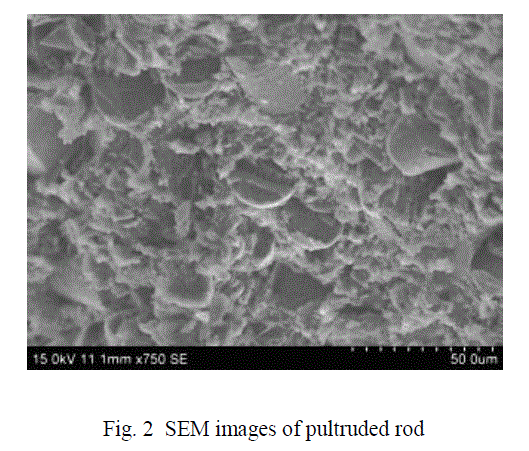 |
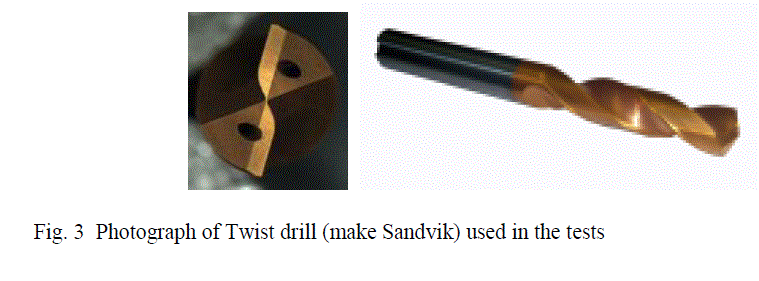 |
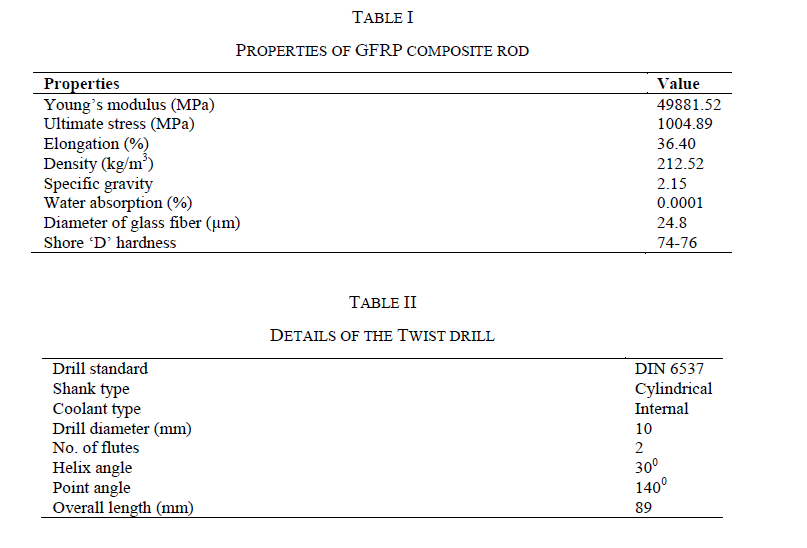 |
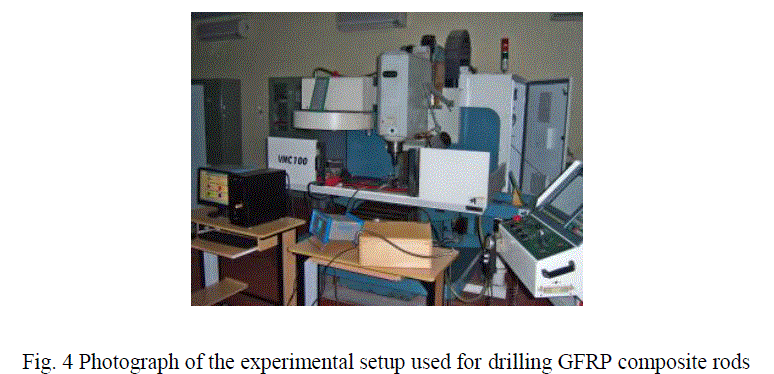 |
| Fixture consisting of V-jaws between which the GFRP rod held was specially designed. The GFRP solid round rod was mounted on the fixture which in turn was mounted on the table of CNC machining center (Fig. 5). The schematic representation of experimental setup is shown in Fig. 6. Vacuum cleaner was used to remove powdery chips away from the cutting zone. The ovality of the drilled holes was measured using coordinate measuring machine (CMM) Tesa Micro-Hite 3D 474 (Fig. 7) which uses Tesa-Reflex MH3D software and adjustable trigger force as probe head. |
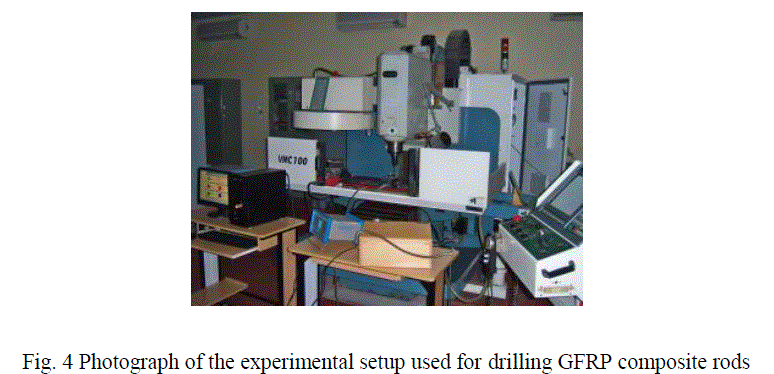 |
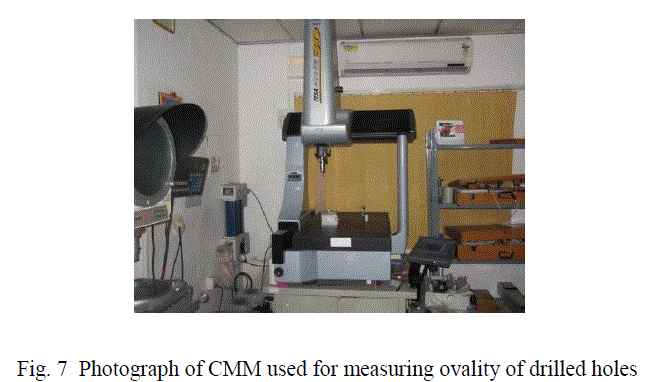 |
| A. Plan of Experiments The experiments were conducted with selected cutting conditions [16] without using coolant. The process parameters and their levels selected for drilling GFRP composite rods are presented in Table III. The orthogonal array L9 as shown in Table IV was selected for this work. |
 |
| This investigation was carried out in nonlaminated composite rods to optimize the process parameter levels within the selected range to attain minimum drilled hole ovality and thereby to attain defect controlled drilling which leads to high hole quality. Each test was repeated thrice and an average was taken for analysis. Analysis of variance (ANOVA) were calculated for the experimental data obtained for average of drilled hole ovality to study the relative significance of process parameters in nonlaminated composite rods. In Taguchi method, S/N ratio is the measure of quality characteristics and deviation from the desired value. In this investigation, “smaller the better” characteristic has been applied to determine the S/N ratio for average of drilled hole ovality as it is to be minimized. A higher the value of S/N ratio means the better the fit for the combined objective. The drilled hole ovality was measured many times at the entry, middle and exit of the drilled holes and an average was taken for analysis. |
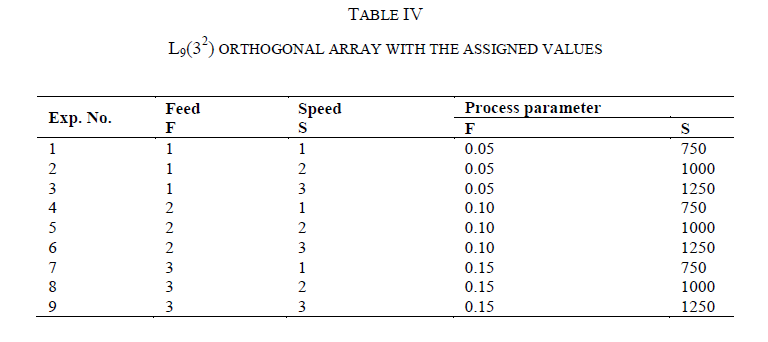 |
III. EXPERIMENTAL RESULTS AND DISCUSSIONS |
| The influence of process parameters (feed and speed) on ovality is discussed below. Two twist drills have been used for making 27 holes. The average flank wear of first twist drill after making 14 holes was 0.1133 mm and that of second twist drill after making remaining holes was also 0.1133 mm. This reveals that effect of flank wear on hole quality will be negligible and hence tool wear is not considered in this study. B. Ovality From Fig. 8 it can be realized that ovality of the drilled hole decreases with increase in speed and feed which is in contrast with [18] where the ovality of the drilled hole decreases with decrease in speed and feed. This may be due to the difference in the geometry of drill used. Also it is observed that lower ovality of the drilled hole can be obtained with medium feed (0.10 mm/rev) and higher speed (1250 rpm). From Table V, it is observed that experiment no. 6 gives minimum ovality in pultruded rods. |
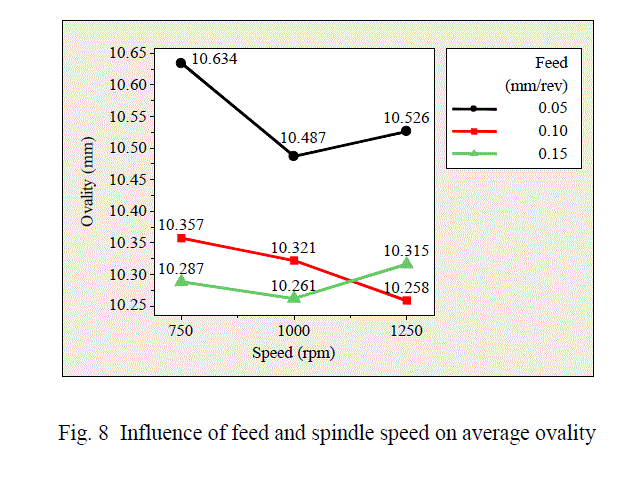 |
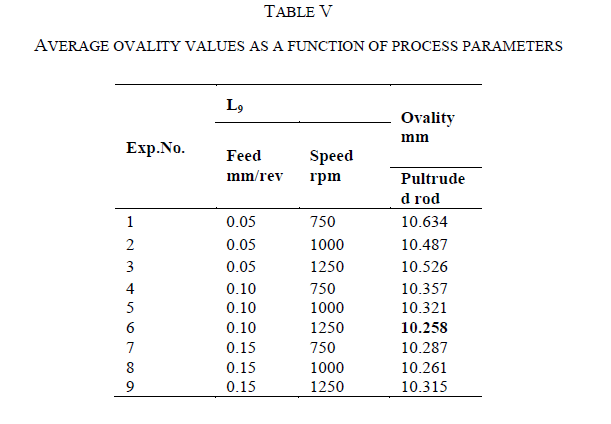 |
| C. Analysis of Variance (ANOVA) and Signal-to-Noise (S/N) Ratio The analysis of variance of the experimental data was done to statistically analyze the relative significance of process parameters, feed (F) and speed (S), on ovality of the drilled holes. The last column of the ANOVA table indicates the percentage of contribution (ρ) of each parameter to the total variation indicating the influence of each parameter. The parameters are not physically significant if their variance ratio is less than the pooled error. From the analysis (Table VI) it is inferred that the process parameter F, feed, has both physical and statistical significance on ovality of the drilled hole. This differs from [18] where the parameter feed has no significance on ovality of the drilled hole. This may be due to the difference in the geometry of drill used. From the analysis (Table VI ) it is inferred that the parameter speed, has no significance on ovality of the drilled hole. This differs from [18] where speed has influence on ovality of the drilled hole. This also may be due to the difference in geometry of drill used. |
 |
| D. Correlation of Ovality with Process Parameters In use of nonlinear regression analysis, the correlation for ovality with process parameters in drilling pultruded GFRP composite rods was obtained using statistical software MINITAB 16. The regression equation is: Ovality in mm = 12 – 13.8 F – 0.00167 S + 42.5 F2 + 0.000001 S2 + 0.00272 FS, (2) R2 = 0.965 and R2 (adj) = 0.908 where F is feed in mm/rev and S is spindle speed in rpm . In multiple regression analysis, R2, which is called R-sq, is the regression co-efficient, where R2 > 0.85 for the models indicates that the fit of the experimental data is satisfactory. Therefore, the model for drilled hole ovality deem to be fit. |
IV. CONCLUSIONS |
| The research in the present study was to optimize the process parameter levels within the range examined based on minimum ovality of the drilled hole and thereby attaining high hole quality in drilling nonlaminated GFRP composite rods using a coated solid tungsten carbide drill. Based on the experimental results and methodology used, the following conclusions can be drawn from drilling pultruded GFRP composite rods using twist drill of diameter 10 mm. |
| 1. The influence of speed on ovality of the drilled holes was insignificant. This differs from drilling nonlaminated composite rods using ratio drill where speed has influence on ovality of the drilled hole. This may be due to the difference in geometry of drill used. 2. The influence of feed was significant (84.40 %) on ovality of the drilled hole. This differs from drilling nonlaminated composite rods using ratio drill where the parameter feed has no influence on ovality of the drilled hole. This may be due to the difference in geometry of drill used. 3. The optimal process parameter levels to attain lower ovality of the drilled hole and thereby producing high quality holes in drilling pultruded GFRP composite rods was identified as 0.15 mm/rev feed and 1000 rpm speed within the range examined. This optimal process parameter level combination gives ovality of the drilled hole in the order of 10.261 mm which is higher than that of using ratio drill. This may be due to the difference in geometry of drill used. 4. The mathematical model developed for ovality of the drilled hole deem to be fit. |
ACKNOWLEDGMENT |
| The authors are grateful to M/s. Sunrise Fibre Glass Industries, Bangalore, India for supplying the composite materials for experimentation. The authors are thankful to Sandvik Coromant India for supplying the drill bits used in this experiments. Also the authors are thankful to Opus Precision Instruments Private Limited, Chennai for assisting in taking ovality measurements. |
References |
|